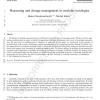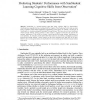861 search results - page 13 / 173 » Predicting change impact from logical models |
PAMI
2010
13 years 5 months ago
2010
—The goal of this work is to develop statistical models for the shape change of a configuration of “landmark” points (key points of interest) over time and to use these mode...
CODES
2007
IEEE
14 years 1 months ago
2007
IEEE
Embedded single-chip heterogeneous multiprocessor (SCHM) systems experience frequent system events such as task preemption, power-saving voltage/frequency scaling, or arrival of n...
DKE
2007
13 years 7 months ago
2007
ct 9 The benefits of modular representations are well known from many areas of computer science. While in software engi10 neering modularization is mainly a vehicle for supporting...
SEKE
2004
Springer
14 years 21 days ago
2004
Springer
In this work, we present an application of the Fuzzy Logic in the field of prediction in Software Engineering. We specifically use the Fuzzy Prototypical Knowledge Discovery for ch...
AIED
2007
Springer
14 years 1 months ago
2007
Springer
SimStudent is a machine-learning agent that learns cognitive skills by demonstration. SimStudent was originally built as a building block for Cognitive Tutor Authoring Tools to hel...


